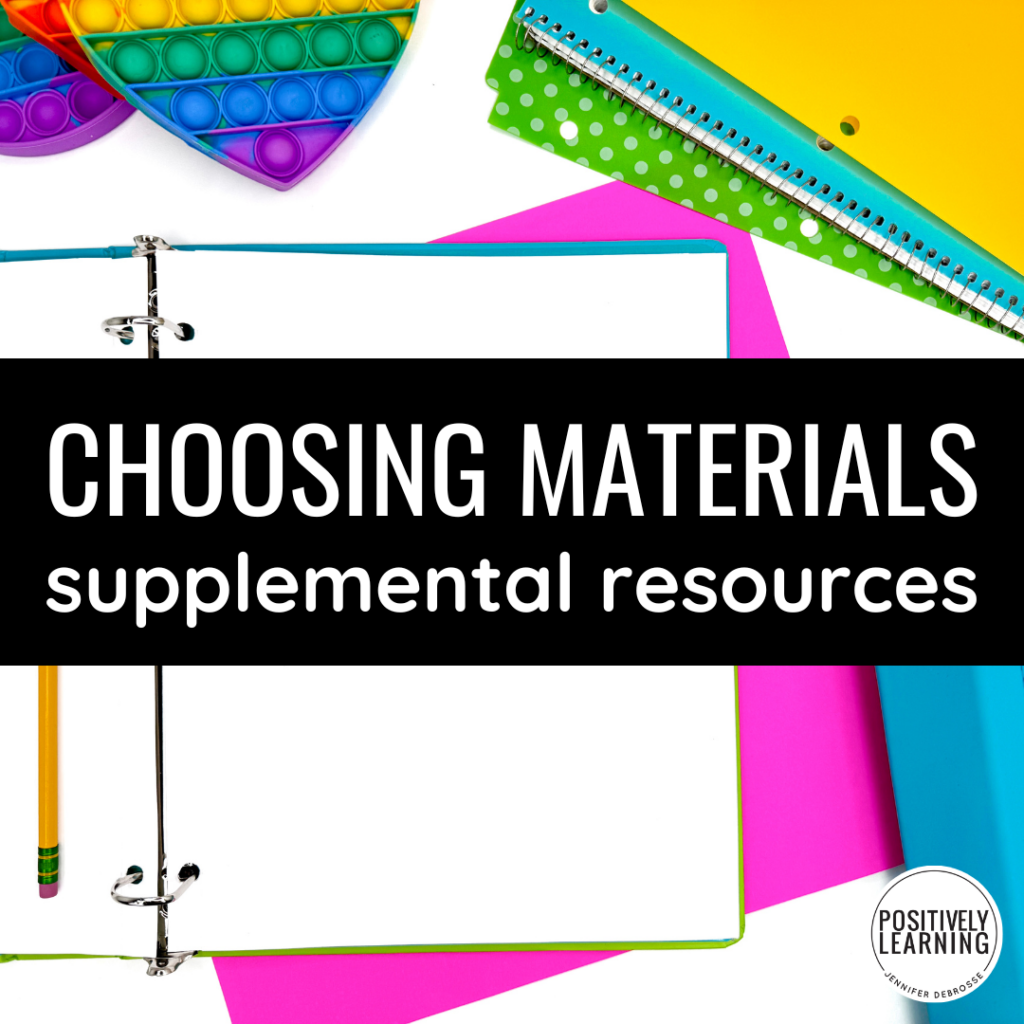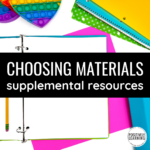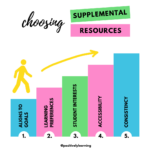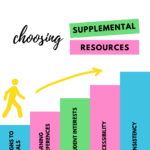
As special educators, we are often on the lookout for supplemental resources to support struggling students. There are so many choices out there, but if you've ever looked you already know that not all educational materials are created equal. In this blogpost, I'm sharing my top criteria for choosing high quality supplemental activities for classroom use.

Table of Contents
ToggleWhat exactly are supplementary resources and how are they used in the special education setting?
These are instructional materials that complement your core curriculum or IEP goals and objectives – think of them as a “bridge” that provides access to core materials.
These instructional resources may offer different ways to present key concepts and provide extra practice to students needing additional support. From digital content to hands-on activities, these types of these resources may also cater to different learning styles and interests.
As a special educator splitting time between the inclusion classroom and resource room setting, I used supplemental resources daily with small intervention groups and independent work systems.
Before I gained more classroom experience, I was trying out ALL the free resources I could find! The result was a lot of clutter and decision fatigue, but luckily this learning process also helped me fine-tune my search.
Here are the top criteria I used to choose just-right resources to support students:
Ensure the learning resources align with your core curriculum and state standards. They should reinforce key concepts, not introduce conflicting ideas.
Look for resources that offer various presentation forms, including auditory, visual, and kinesthetic learners. This could range from educational videos and digital games to print materials and hands-on activities.
Choose resources that will captivate your students' interests. Engagement is the first step toward meaningful learning, so opt for materials that are visually appealing, interactive, and relevant to their lives.
Resources should be user-friendly for your students. Check for ease of navigation, clarity of instructions, and accessibility for students with different needs.
Select materials that encourage critical thinking, creativity, and application of knowledge. Look for resources that provide real-world examples, promote problem-solving, and allow for exploration beyond “textbook content.”
When integrating visual elements into your supplementary resources, consider the following aspects to enhance their effectiveness:
Choose materials with clean, uncluttered layouts to help students focus on the essential content. Too many visuals or text crammed into a small space can be overwhelming and detract from the learning experience.
Select resources with fonts that are easy to read. Fonts should be large enough for students to read comfortably and without strain. Avoid decorative fonts in favor of clear, simple ones that facilitate reading and comprehension.
Use resources with a good contrast between text and background to ensure that all students, including those with visual impairments, can access the information. Colors can be used to highlight key concepts, but shouldn't cause distraction or confusion.
Ensure that the visuals included are relevant to the subject matter and support the learning objectives. Clipart, diagrams, and charts should add value to the text, aiding in the explanation of complex ideas and providing visual representations of abstract concepts.
Maintain consistency in the use of visuals across different materials. This consistency helps students become familiar with the format and structure, making it easier for them to navigate and understand the resources.
Now that you have filtered out the fluff and know exactly what you're looking for, here's some avenues to check out:
Digital Resources – Online platforms and digital content offer dynamic, interactive ways to engage with material. Educational games, simulation software, and digital media can make learning immersive and fun. Idea: Positively Learning on Boom Learning
Print Materials – Traditional doesn't mean outdated. Workbooks, visual aids, and printed lesson plans can offer solid support, especially when technology is not an option. Idea: Positively Learning on Teachers Pay Teachers
Hands-on Activities – Hands-on tasks provide tactile experience and fine motor learning opportunities, crucial for students who thrive beyond screens. Idea: Task Box Dollar Club
The use of supplemental materials is not just about adding “more” to the busy school day, but as helpful tools to enhance learning and increase student understanding. When thoughtfully chosen, they can create a learning enviroment where students feel seen, heard, and inspired.

I’m Jennifer and I was a special educator in the elementary school setting over the past decade. I entered the classroom every day dedicated to making learning inclusive AND engaging.




This website uses cookies to ensure you get the best experience on our website. See full disclosure here.
This website uses cookies to ensure you get the best experience on our website.
See full disclosure here.